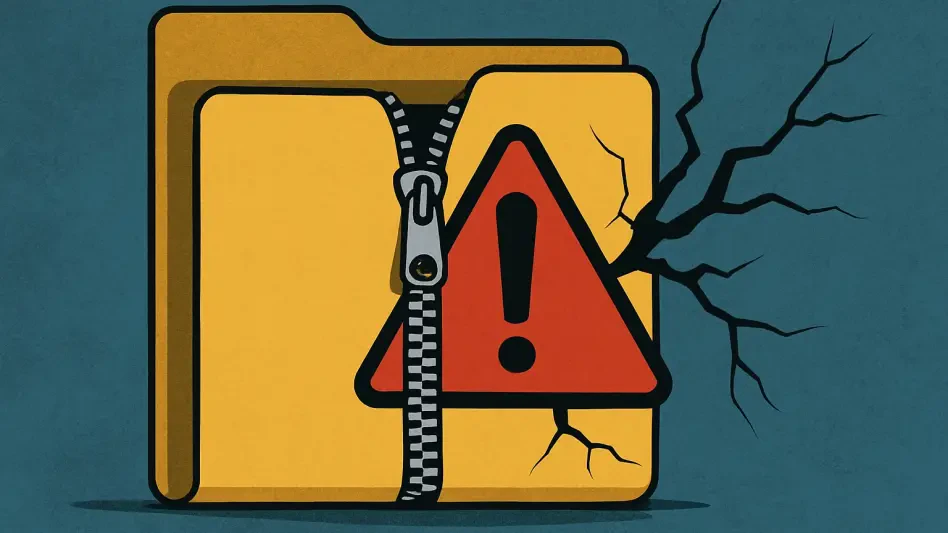Imagine a widely used, free tool on millions of devices suddenly becoming a gateway for cybercriminals to infiltrate systems with just a single click, a scenario that has now become a harsh reality for users of 7-Zip, a popular file compression software, due to a recently discovered vulnerability. Tracked as CVE-2025-11001, this flaw carries a high-risk warning from authoritative bodies like the UK’s NHS England Digital, highlighting the potential for severe exploitation. Although active attacks have not yet been widely observed in the wild, the existence of a public proof-of-concept (PoC) exploit has raised the stakes significantly. This situation underscores the urgent need for users to take immediate action to protect their systems. As the threat landscape evolves, understanding the nature of this vulnerability and the steps required to mitigate it becomes paramount for both individual users and organizations relying on this tool for daily operations.
1. Understanding the Vulnerability in 7-Zip
The core issue with 7-Zip lies in how older versions of the software handle symbolic links within ZIP files, which are essentially shortcuts to other files or directories. Identified as a Directory Traversal Remote Code Execution (RCE) flaw, this vulnerability allows a maliciously crafted ZIP file to bypass security measures during extraction. As a result, attackers can navigate to unauthorized system directories and execute arbitrary code, potentially compromising the entire system. This flaw, which carries a CVSS risk score of 7.0 (classified as High), requires user interaction—specifically, the target must open the infected archive. Discovered by Ryota Shiga of GMO Flatt Security Inc., with assistance from an AI tool, this vulnerability poses a significant threat due to its potential for exploitation. Windows systems are exclusively affected, making it a critical concern for a vast number of users who rely on this platform for personal and professional tasks.
Beyond the technical specifics, the danger of this flaw is amplified by three critical factors. First, extracting a malicious ZIP file can enable attackers to execute code under high-privilege accounts, such as service accounts, potentially leading to a full system takeover. Second, the simplicity of the exploit—requiring only that a user opens the archive—makes it accessible even to less sophisticated attackers. Third, 7-Zip’s widespread adoption across industries creates a massive attack surface of unpatched systems. According to vulnerability detection platforms, this combination of factors elevates the risk to unprecedented levels. The public availability of a working PoC exploit, shared by a security researcher known as pacbypass, further accelerates the likelihood of attacks, providing cybercriminals with a ready-made blueprint to target vulnerable systems. This underscores the urgency for users to address the issue before it escalates into widespread exploitation.
2. Rising Threats and Industry Response
The threat level associated with this 7-Zip vulnerability has surged with the public release of exploit code, making it easier for malicious actors to craft attacks. Microsoft has already identified activity linked to this flaw under a specific detection label, indicating that malware campaigns are beginning to leverage the public PoC. While widespread exploitation has not yet been confirmed, the detection of related malicious activity suggests that attackers are actively testing or deploying this vulnerability in targeted scenarios. This development is particularly concerning for systems where files are extracted under highly privileged accounts, as such conditions could enable attackers to gain complete control over affected machines. The industry’s response has been swift, with security experts emphasizing the need for immediate action to prevent potential breaches that could compromise sensitive data or critical infrastructure.
In addition to monitoring malicious activity, organizations and security researchers have been vocal about the broader implications of this flaw. The ease of exploitation combined with the lack of awareness among many users creates a perfect storm for cybercriminals to exploit. Reports indicate that the vulnerability’s impact is most severe on Windows systems, where unpatched versions of 7-Zip remain in use across both personal and enterprise environments. Given the software’s popularity, the potential for large-scale attacks cannot be overstated. Security advisories have been issued to alert users to the risks, with a strong emphasis on updating systems as a primary defense mechanism. As the situation unfolds, collaboration between software developers, security firms, and end users will be essential to mitigate the risks and prevent this vulnerability from becoming a widespread crisis in the digital landscape.
3. Steps to Secure Systems Against the Threat
Addressing this critical flaw requires proactive measures, as the software does not feature an automatic update mechanism. The issue was resolved in version 25.00, released earlier this year, with the latest version, 25.01, offering the most secure option for users. However, users must manually update their installations, a process that can be challenging for those unfamiliar with software management. To protect systems, it is necessary to identify all instances of 7-Zip older than version 25.00 on Windows machines and install the updated version promptly. For enterprise environments, deployment tools or scripts, such as Microsoft Intune, can facilitate this process across multiple systems. Users can download the latest version directly from the official 7-Zip download page, ensuring they obtain the software from a trusted source to avoid additional security risks.
For those managing multiple systems or lacking technical expertise, the manual update requirement poses a significant hurdle. Experts have noted that the absence of automated patching means many systems likely remain vulnerable, as users may be unaware of the flaw or the need to update. To minimize exposure, it is advisable to limit the extraction of ZIP files from untrusted sources until updates are applied. Additionally, organizations should prioritize educating employees about the risks associated with opening unknown archives, as user interaction is a key component of this exploit. Implementing these protective measures can significantly reduce the likelihood of falling victim to attacks exploiting this flaw. As a long-term strategy, integrating vulnerability scanning tools into system management practices can help detect and address similar issues before they are exploited by malicious actors.
Final Thoughts: Building Resilience Against Exploits
Reflecting on the response to this 7-Zip vulnerability, it becomes evident that manual intervention played a crucial role in safeguarding systems. The swift identification and patching of the flaw in version 25.00 demonstrated the importance of timely software updates, even when automation was not an option. Moving forward, users and organizations should consider adopting proactive security practices, such as regular system audits and employee training on recognizing suspicious files, to prevent similar incidents. Exploring automated patch management solutions for other critical software can also reduce the burden of manual updates in the future. By staying vigilant and prioritizing security hygiene, the risk of exploitation can be minimized, ensuring that systems remain protected against evolving threats in an increasingly complex digital environment.








